Walk through Rochester's Washington Grove, a rare remnant of nation's old-growth forests
This story was produced as part of a larger project for the USC Annenberg Center for Health Journalism’s 2021 Data Fellowship.
Other stories by Justin Murphy include:
How did some Rochester neighborhoods become greener than others?
‘I now see the disparity is real.’ For Rochester’s mayor, trees are a justice issue
Rochester’s trees are celebrated, but not everyone gets to have their time in the shade
This project mapped every tree in Rochester. Here’s how we did it
Sign up to learn about Rochester's trees by texting with reporter Justin Murphy
Tell us the story of your favorite tree in Rochester. Where is it and why is important?
Read about Rochester’s most beloved trees and share your own story
Rochester's trees make Landmark Society of Western New York's annual 'Five to Revive' list
Take a walk around Washington Grove, a 26-acre stand of trees east of Cobbs Hill reservoir
Washington Grove, a 26-acre stand of trees east of the Cobbs Hill reservoir is one of the few examples of an old growth forest remnant in an urban area. Shawn Dowd, Rochester Democrat and Chronicle
Rochester's boosters have long pointed with pride at the city's most verdant boulevards and parkways to label it a "city in a forest."
That description is better applied to certain sections of the city than to others. Rochester can, however, boast of the converse: a forest in the city.
Washington Grove, a 26-acre stand of ancient trees east of the Cobbs Hill reservoir, is one of the few examples in the nation of an old-growth forest remnant in an urban area.
For a city with grand green aspirations, the grove is a tremendous asset — but it represents inequity as well.
Its main entrance is in the Cobbs Hill neighborhood, which supplies many of its regular walkers and most zealous protectors. Entrances on the park side of the woods, meanwhile, are poorly marked and maintained and in some cases dangerous.
Washington Grove in Rochester Washington Grove, an old growth gem in the city of Rochester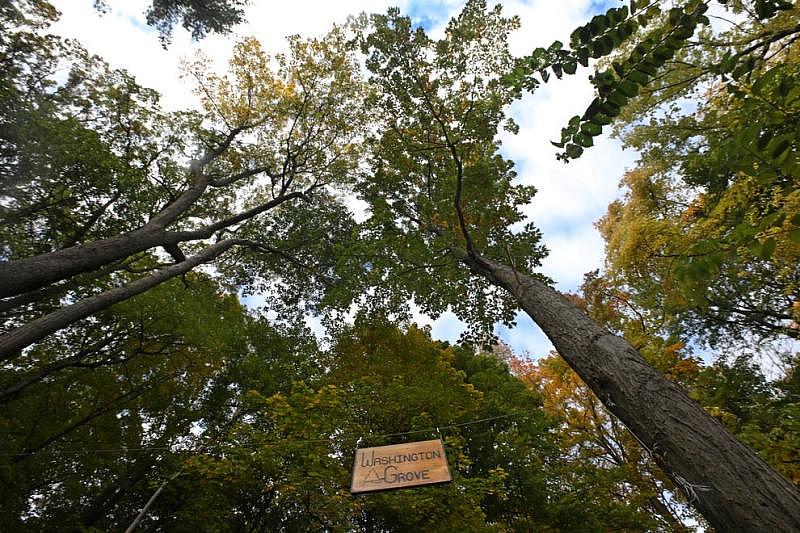
A cursory census of woods users confirms the predictable outcome: people of color are rare. Instead, Rochester's most lavish natural setting has been effectively reserved for its white, wealthy and well-connected citizens.
The city, together with the nonprofit group that helps maintain the grove, are now trying to change that dynamic — though funding, as always, poses a challenge.
"I’m responsible for telling so many people, ‘You’ve got to check out Washington Grove,’" said Mayor Malik Evans, who can see the grove from his house on Nunda Boulevard. "I think there’s definite room for improvement and an opportunity to be able to do that."
Addressing exclusion
The grove's oldest trees are believed to be more than 200 years old. They somehow were spared in the late 19th century when clay and gravel quarries claimed much of the rest of the surrounding Pinnacle moraine. The city took possession in 1912 and, in 1932, designated the tract as Washington Grove.
The main entrance is at the western end of Nunda Boulevard, the centerpiece of one of the city's leafiest and most affluent neighborhoods. The entrance was meticulously landscaped with glacial erratic boulders in 1937 and then restored in 2020 with new signage and broad, sturdy steps.
"Once you are in among the trees, large and small, you will forget that there are city streets on all sides," an Arbor Day speaker said on a radio program in 1936. "You will be conscious only of the dry rustling leaves below, the trees and sky above, the grandeur of the forest, and the language of the woodland."
Foxes, turkeys and deer live in the forest, which also serves as an important migratory byway for birds. More than 140 different bird species have been spotted there, according to the Friends of Washington Grove, a nonprofit group that officially formed in 2013.
The group leads educational tours, helps maintain the trails and serves as adviser and contractor to city government on ecological concerns, in particular removing and controlling non-native species like Norway maples, buckthorn and swallowwort.
In the last several years the group, whose board of directors is all white, has expanded those traditional activities to attempt to address exclusionary effects of race and class discrimination as they relate to the grove.
"We need to make sure this is not just a beautiful place for the neighborhood and rich folks who can drive in," said Andrew Seager, until recently the president of Friends of Washington Grove. "We need to make sure it's a place where people of color and others are welcome." 'It's easy to breathe' The grove's enthusiasts refer to it fondly as Rochester's hidden gem - and it is indeed hidden if one seeks to enter through the poorly maintained, barely visible entrances on the reservoir side of Cobbs Hill Park. Those are the entrances facing the more diverse clientele that visits the park for the reservoir, the view of the downtown skyline and the basketball and tennis courts. Yet many of those people do not know that the grove exists.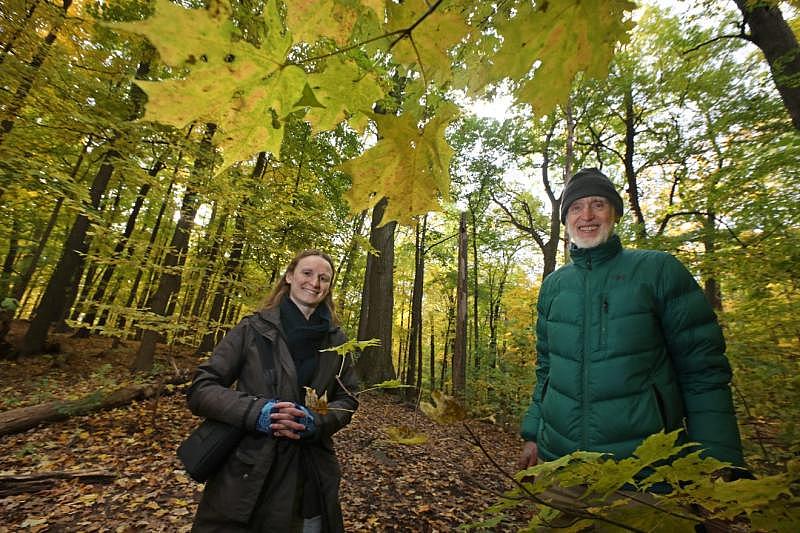
"We need to make sure this is not just a beautiful place for the neighborhood and rich folks who can drive in," said Andrew Seager, until recently the president of Friends of Washington Grove. "We need to make sure it’s a place where people of color and others are welcome."
'It's easy to breathe'
The grove's enthusiasts refer to it fondly as Rochester's hidden gem — and it is indeed hidden if one seeks to enter through the poorly maintained, barely visible entrances on the reservoir side of Cobbs Hill Park.
Those are the entrances facing the more diverse clientele that visits the park for the reservoir, the view of the downtown skyline and the basketball and tennis courts. Yet many of those people do not know that the grove exists.
Early morning light shines through the thick canopy in Washington Grove in Rochester Monday, Nov. 1, 2021. Shawn Dowd, Democrat And Chronicle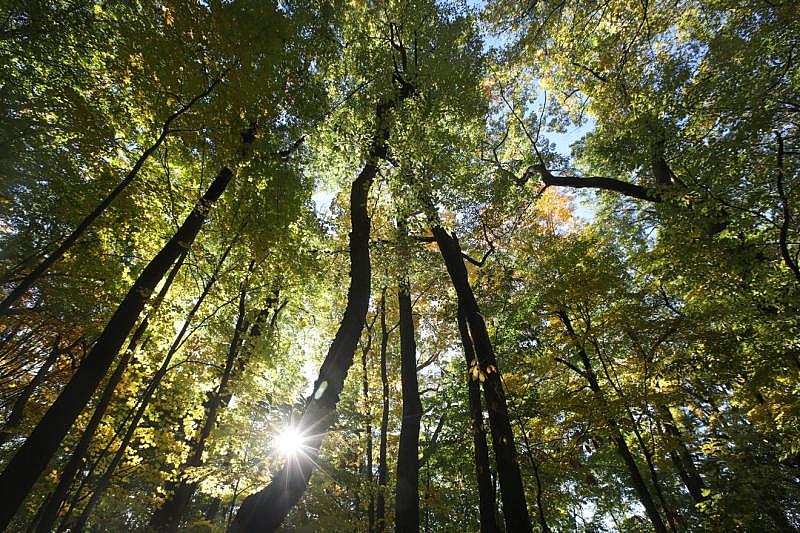
A 2016 consultant report commissioned by the city described the entrances on that side of the grove as "very steep and potentially unsafe," damaged by erosion and poorly marked. In some places would-be hikers must step over a fence or trespass through private property to get to the main trail network.
"The entrances are just holes in the wall," said Linden Burack.
He and several other teenaged ecologists were sitting in lawn chairs and huddled against blasts of cold November wind in the grassy expanse between the reservoir and the woods.
They are members of the Urban Ecology Program, affiliated with Seneca Park Zoo and managed by former Rochester City School District science teacher Chris Widmaier. Throughout the summer they had set up a stand there each week, trying to interest reservoir strollers in the "hidden gem" nearby.
That was the summer. Now, it was freezing.
Once the teenagers packed up their thermoses of hot chocolate and filed into the woods, though, the change was appreciable. The trees, even without their leaves, batted down the wind. Then the sun came out.
The effect was vivifying and the previously frost-bound students sprang to life, picking up leaves, brushing off mosses and craning their necks at breaks and burls high on the towering maples, sycamores and tulip trees.
Chris Widmaier, executive director of Rochester Ecology Partners, center, identifies different tree types from their leaves with DeShawn Griffin, left, including the tulip tree leaf that he holds, during a walk around Washington Grove in Rochester with students participating in the Seneca Park Zoo Society's Urban Ecologist program Saturday, Nov. 13, 2021. Shawn Dowd, Democrat And Chronicle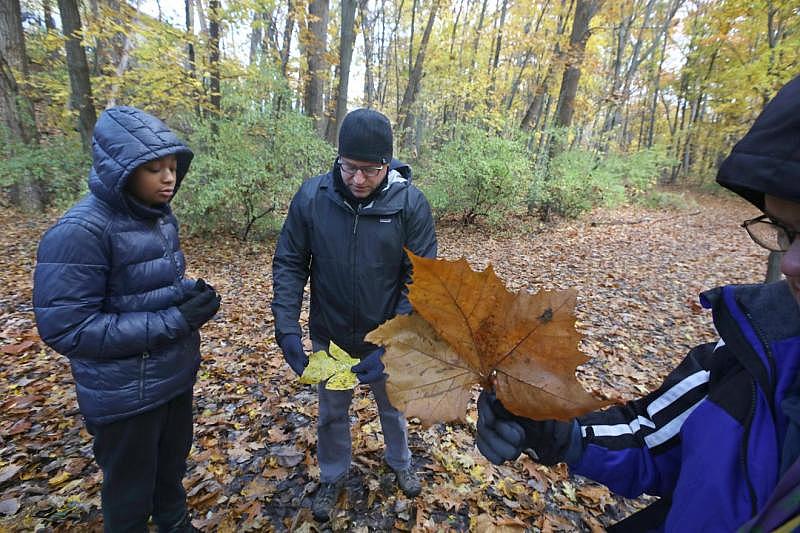
DeShawn Griffin, another group member, recalled the way the changes in temperature and air quality hit him the first time he stepped into the woods.
"It’s just way more peaceful in here; it’s easy to breathe," he said. "It’s like when we walked in here and everything just changed immediately. That’s how it is for me. It’s a change."
'...further down the road'
The clearest way to improve access to Washington Grove is to establish better access points, in particular on the reservoir side, together with new signage. The trails also lack a handicapped-accessible entrance.
The city's 2016 report recommends making those changes. All that has happened since then, though, is the restoration of the Nunda Boulevard entrance — paid for mostly by Friends of Washington Grove, not the city — and a new sign near the reservoir.
"We've had good collaboration, but it hasn't been a city priority," Seager said. "I'm hoping the new mayor ... will be more attentive than the previous administration."
Evans and top administration officials said in interviews there's no current plan to make significant changes to the reservoir-side entrance.
"it would be a major, major overhaul to the look of that area," Director of Recreation and Park Stewardship Sara Scott said. "I certainly think the city is absolutely committed to making that space accessible to all … but some of those large changes, I think, are further down the road."
Instead the immediate goal is to improve signage on the reservoir side and to clear out debris to make the existing entrance more prominent.
Seager has urged the city to go further and create a comprehensive plan for all of Cobbs Hill Park, including the grove.
"We really want the city to think about that park as a whole," Seager said. "We can’t just separate out small pieces of ecology from one another."
One crisp, sunny day in November, a few dozen mostly Black and Latino college students from local fraternal organizations spent an afternoon doing clean-up and maintenance at the grove, filling wobbly wheelbarrows with mulch and raking it onto the paths.
Natalie Robinson, student at RIT, pushes a load wood chips up the trail as area college students that are part of La Unidad Latina, Lambda Upsilon Lambda Fraternity, Inc., help with putting down fresh mulch along trails in Washington Grove in Rochester Saturday, Nov. 6, 2021, as part of the group's annual National Day of Giving. Shawn Dowd, Democrat And Chronicle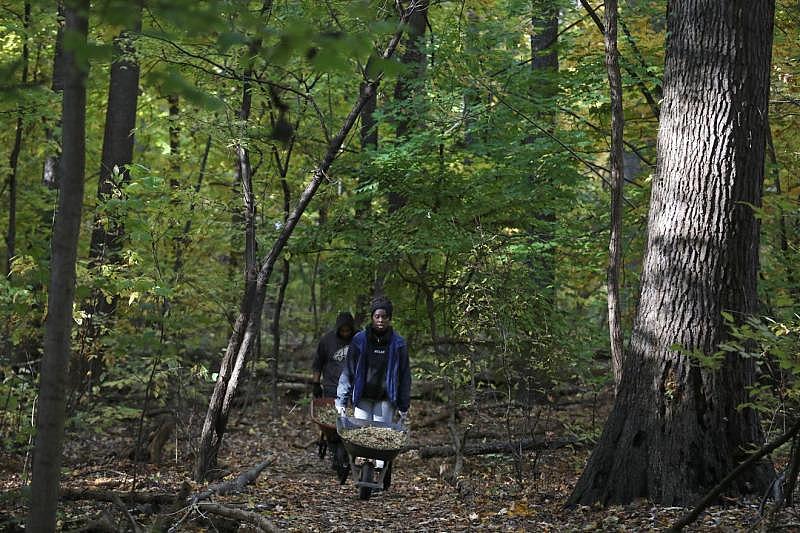
Among them was Natalie Robinson, a Rochester Institute of Technology student working on a capstone project related to the effect of green space in education.
Growing up in Irvington, New Jersey, Robinson said she "didn't have the vocabulary" to articulate her need to escape the city and be amid nature.
"You feel kind of trapped – all you know is the indoors," she said. "(People feel) like they don’t have an outlet. And green space can be that outlet.”
Contact staff writer Justin Murphy at jmurphy7@gannett.com.
Sierra Club to give out free trees
The Rochester Regional Group Sierra Club will distribute free trees from 10 a.m. to 3 p.m. Saturday, April 30, at four locations in Monroe County.
The organization gave away more than 1,000 trees at a similar event last year and hopes to double that tally this year, board member John Kastner said. The trees will come with planting and care instructions.
The locations are Seneca Park, Genesee Valley Park (near the swimming pool on Elmwood Avenue), Northampton Park and Webster Park.
For more information go to www.sierraclub.org/atlantic/rochester.
[This story was originally published by Democrat & Chronicle.]

